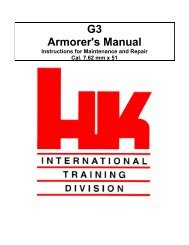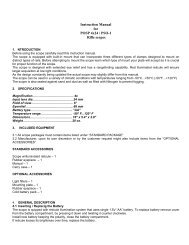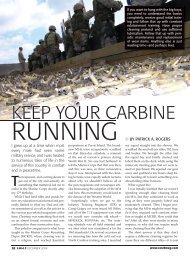FM 21-76 US ARMY SURVIVAL MANUAL - AR15.com
FM 21-76 US ARMY SURVIVAL MANUAL - AR15.com
FM 21-76 US ARMY SURVIVAL MANUAL - AR15.com
Create successful ePaper yourself
Turn your PDF publications into a flip-book with our unique Google optimized e-Paper software.
<strong>FM</strong> <strong>21</strong>-<strong>76</strong> <strong>US</strong> <strong>ARMY</strong> <strong>SURVIVAL</strong> <strong>MANUAL</strong> Reprinted as permitted by U.S. Department of the Army<br />
Chop Fishing<br />
At night, in an area with a good fish density, you can use a light to attract fish. Then, armed with a<br />
machete or similar weapon, you can gather fish using the back side of the blade to strike them. Do not<br />
use the sharp side as you will cut them in two pieces and end up losing some of the fish.<br />
Fish Poison<br />
Another way to catch fish is by using poison. Poison works quickly. It allows you to remain concealed<br />
while it takes effect. It also enables you to catch several fish at one time. When using fish poison, be sure<br />
to gather all of the affected fish, because many dead fish floating downstream could arouse suspicion.<br />
Some plants that grow in warm regions of the world contain rotenone, a substance that stuns or kills<br />
cold-blooded animals but does not harm persons who eat the animals. The best place to use rotenone,<br />
or rotenone-producing plants, is in ponds or the headwaiters of small streams containing fish. Rotenone<br />
works quickly on fish in water <strong>21</strong> degrees C (70 degrees F) or above. The fish rise helplessly to the<br />
surface. It works slowly in water 10 to <strong>21</strong> degrees C (50 to 70 degrees F) and is ineffective in water<br />
below 10 degrees C (50 degrees F). The following plants, used as indicated, will stun or kill fish:<br />
Anamirta cocculus (Figure 8-23). This woody vine grows in southern Asia and on islands of the South<br />
Pacific. Crush the bean-shaped seeds and throw them in the water.<br />
Croton tiglium (Figure 8-23). This shrub or small tree grows in waste areas on islands of the South<br />
Pacific. It bears seeds in three angled capsules. Crush the seeds and throw them into the water.<br />
Barringtonia (Figure 8-23). These large trees grow near the sea in Malaya and parts of Polynesia. They<br />
bear a fleshy one-seeded fruit. Crush the seeds and bark and throw into the water.<br />
Derris eliptica (Figure 8-23). This large genus of tropical shrubs and woody vines is the main source of<br />
commercially produced rotenone. Grind the roots into a powder and mix with water. Throw a large<br />
quantity of the mixture into the water.<br />
Duboisia (Figure 8-23). This shrub grows in Australia and bears white clusters of flowers and berrylike<br />
fruit. Crush the plants and throw them into the water.<br />
Tephrosia (Figure 8-23). This species of small shrubs, which bears beanlike pods, grows throughout the<br />
tropics. Crush or bruise bundles of leaves and stems and throw them into the water.<br />
Page 93 of 233








